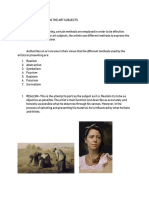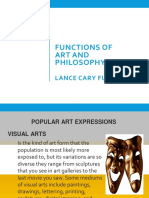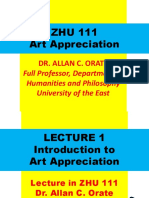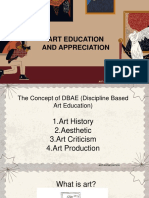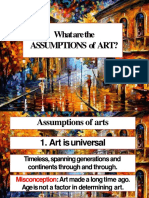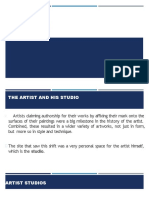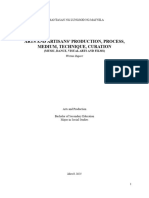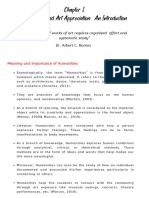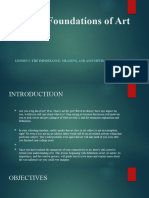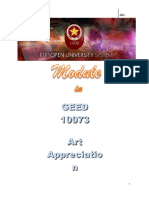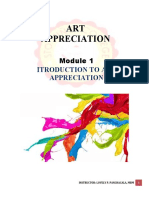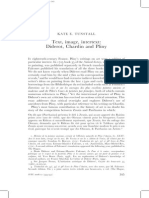Lesson 1
LESSON 1: WHAT IS ART? INTRODUCTION AND ITS ASSUMPTIONS?
ART
Art is a highly diverse range of human activities engaged in creating visual, auditory, or
performed artifacts— artworks—that express the author’s imaginative or technical skill,
and are intended to be appreciated for their beauty or emotional power.
The oldest documented forms of art are visual arts, which include images or objects in
fields like painting, sculpture, printmaking, photography, and other visual media.
Architecture is often included as one of the visual arts; however, like the decorative
arts, it involves the creation of objects where the practical considerations of use are
essential, in a way that they usually are not in another visual art, like a painting.
Art may be characterized in terms of mimesis (its representation of reality), expression,
communication of emotion, or other qualities. Though the definition of what constitutes
art is disputed and has changed over time, general descriptions center on the idea of
imaginative or technical skill stemming from human agency and creation. When it
comes to visually identifying a work of art, there is no single set of values or aesthetic
traits. A Baroque painting will not necessarily share much with a contemporary
performance piece, but they are both considered art.
Despite the seemingly indefinable nature of art, there have always existed certain
formal guidelines for its aesthetic judgment and analysis. Formalism is a concept in art
theory in which an artwork’s artistic value is determined solely by its form, or how it is
made. Formalism evaluates works on a purely visual level, considering medium and
compositional elements as opposed to any reference to realism, context, or content.
Art is often examined through the interaction of the principles and elements of art. The
principles of art include movement, unity, harmony, variety, balance, contrast,
proportion and pattern. The elements include texture, form, space, shape, color, value
and line. The various interactions between the elements and principles of art help
artists to organize sensorial pleasing works of art while also giving viewers a framework
within which to analyze and discuss aesthetic ideas.
ART HISTORY
Art history doesn’t consist in simply listing all the art movements and placing
them on a timeline. It is the study of objects of art considered within their time period.
Art historians analyze visual arts’ meaning (painting, sculpture, architecture) at the time
they were created. Also, another of art history’s mission is to establishes authorial
�origins of artworks, i.e. discovering who created a particular artwork, when, when and
for what reason.
Iconography is a major part of art history. It consists in analyzing the symbolism of
works of arts. For instance, art historians identify the visual elements of a painting and
interpret its meaning. Art historians are interested in what the works of art represented
at the time they were created. It is a way to learn about the civilizations of the past.
ART APPRECIATION
The term art appreciation is referred to the knowledge of the general and everlasting
qualities that classify all great art. It is seen used to refer to the exploration of visual art
forms or the introduction of basic principles of visual literacy. It refers to analyzing the
form of an artwork to general audiences to enhance their enjoyment of such works of
art. It may be analyzed without reference to subject matter, symbolism or historical
context. Art appreciation can be subjective depending on personal preference to
aesthetics and form, or it can be based on several elements and principle of design and
also depends on social and cultural acceptance. Most of the modern art critics and art
historians draw back from this term, underrating art appreciation as demanding too
little serious thought.
Art Creativity, Imagination, and Expression
It takes an artist to make an art. One may perceive beauty on a daily basis. However,
not every beautiful thing that can be seen or experienced may be truly called a work of
art. Art is a product of man’s creativity, imagination and expression. No matter how
perfectly the colors of sunset are and no matter how extraordinarily formed mountains
are, nature is not considered art simply because it is not made by made. Not even
photographs or sketches of nature, though captured or drawn by man, are works of
art, but mere recordings of the beauty in nature (Collins & Riley, 1931). An artwork
maybe inspired by nature or other works of an art, but an artist invents his own forms
and patterns due to what he perceives as beautiful and incorporates them in creating
his masterpiece.
Art Appreciation as a Way of Life:
In old town Quito, we came across a most amazing art exhibit. The art, split into 4
sections, portrayed the indigenous people over the last century. It was beautiful and
moving. "Hard working" is the theme throughout it all. I loved, loved this exhibit. In
�fact, when we first discovered it, we were only able to view the first section before it
closed for the night. Naturally we had to return at a later day.
(Source:http://bekatelyn.com/notes/entry/art-depicting-indigenous-life)
The role of art as a creative work is to depict the world in a completely different
and light perspective. (Jean-Paul Sarte)
Each artwork beholds beauty in its own kind, the kind that the artist sees and
wants the viewers to perceive;
More often than not, people are blind to this this beauty and only those who
have developed a fine sense of appreciation can experience and see the art
the same way the artist did. Hence, refining one’s ability to appreciate arts
allows him to deeply understand the purpose of an artwork and recognize the
beauty it possesses;
In cultivating an appreciation of art, one should also exercise and develop his
taste for things that are fine and beautiful;
This allows individuals to make intelligent choices and decisions in acquiring
necessities and luxuries, knowing what gives better value for time or money
while taking into consideration the aesthetic and practical value; and
Learning to appreciate art no matter what vocation or profession you have, will
lead to a fuller and more meaningful life
The Role of Creativity in Art Making
Creativity requires thinking outside the box
In art, creativity is what sets apart one artwork from another
�
Source: https://www.artworkarchive.com/blog/what-is-the-artist-s-role-in-society
Art as a Product of Imagination, Imagination as a Product of Art
Where do you think famous writers, painters and musicians get their ideas?
Where do ideas in making creative solutions begin? It all starts in the human mind, it
all begins with imagination. Imagination is more important than knowledge. For
knowledge is limited to all we know and understand while imagination embraces the
entire world and all there ever will be to know and understand. In an artist’s mind sits a
vast gallery of artwork. An artwork does not need to be a real thing, but can be
something that is imaginary (Collingwood, 1938). The making of this tune in his head
makes it an imaginary tune, an imaginative creation, an imaginary art. It remains
imaginary until he hums, sings, or writes down the notes of the tune on paper.
However, something imaginary does not necessarily mean, it can be called art. In the
same way that imagination produces art, art also inspires imagination. Imagine being
in an empty room surrounded by blank, white walls, and floor. Would you be inspired
to work in such place?

